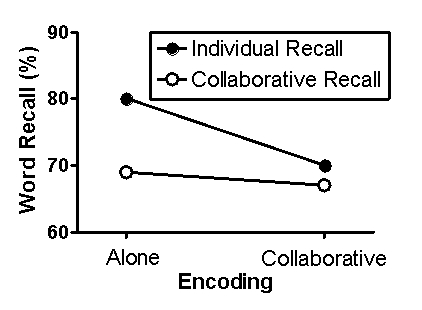Use the following to answer questions
Scenario I
Scenario I is based on and provides fabricated data consistent with the following study:
Barber,S.J. ,Rajaram,S. ,& Fox,E.B.(2012) .Learning and remembering with others: The key role of retrieval in shaping group recall and collective memory.Social Cognition,30(1) ,121-132.doi:10.1521/soco.2012.30.1.121
In a typical experiment on collaborative memory,participants first encode information individually and later attempt to recall the information either individually or in a small group (collaboratively) .While the recall of the collaborative group is better than that of any individual,the summed recall of individuals typically is better than the recall of the collaborative group.This is a phenomenon termed collaborative inhibition.Barber,Rajaram,and Fox (2012) investigated this phenomenon during both the encoding and retrieval stages of memory.
Participants created sentences out of a word bank,which provided for the opportunity to encode this information.After completing this task,participants engaged in an unrelated task-solving mazes-for 10 minutes.Then,in a surprise memory test,they were asked to recall as many words from the word bank as possible (retrieval) .
Participants were randomly assigned to one of four groups.In the first group (Alone-Alone) ,participants were studied individually during both the encoding and retrieval phases of the experiment.In the second group (Alone-Collaborative) ,participants were studied individually during the encoding phase and studied as part of a three-member team (triad) during the retrieval phase.In the third group (Collaborative-Alone) ,participants were studied in a triad during the encoding phase but individually during the retrieval phase.Finally,in the fourth group (Collaborative-Collaborative) ,participants completed both phases of the experiment as part of a triad.
Fabricated results illustrating the major finding of Barber et al.(2012) are presented in Figure 6.1.This figure shows the percentage of words from the word bank accurately recalled as a function of group.For the two groups that experienced the retrieval phase individually,scores represent the summed retrieval of the individuals comprising the group.For the two groups that experienced the retrieval phase as part of a triad,scores simply represent the collaborative performance.
Figure 6.1 
-(Scenario I) Which statement is TRUE?
Definitions:
Work Experience
Refers to the jobs and positions an individual has held, detailing the roles, responsibilities, and duration of each.
Greater Flexibility
Often refers to improved adaptability or versatility in policies, systems, or physical capabilities.
Government Agencies
Organizations at the federal, state, or local level that administer and enforce laws, provide public services, and support the government’s operations.
Legal Services
Professional services provided by lawyers or legal practitioners involving legal advice, representation, and other law-related support.
Q8: (Scenario I)This experiment examined which type of
Q15: A doctor gives a patient in chronic
Q34: In a narcoleptic attack,a person engaged in
Q61: Long-term storage is to short-term storage as:<br>A)enhanced
Q69: Chimpanzees raised in the wild watched a
Q79: The majority of persons aged 12 and
Q86: If you wake sleepwalkers,they probably will report
Q176: Superior recall of a scenario is often
Q290: A hungry monkey's lever-pressing behavior is reinforced
Q336: We rely heavily on _ memory to